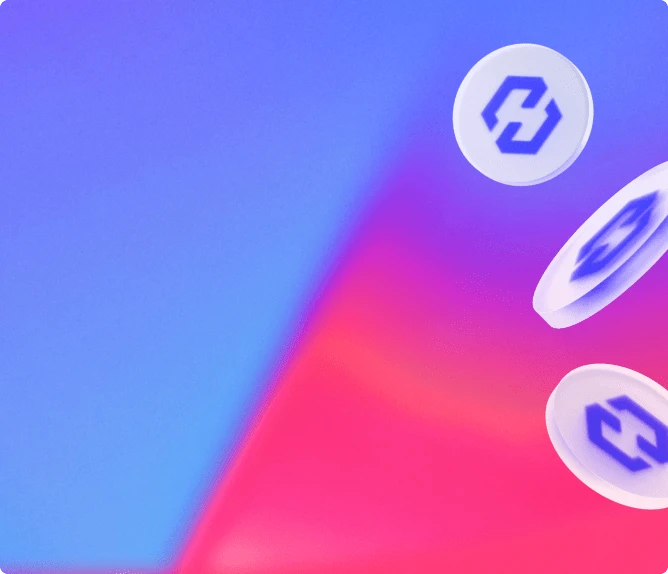Investing in crypto-assets carries risks of liquidity, volatility, and partial or total capital loss. Crypto-assets held are not covered by deposit and securities guarantee mechanisms.


Sign up for our newsletter
Partners
Coinhouse
Our accounts
Coinhouse
Coinhouse SAS with a capital of €210,000, RCS Paris 815 254 545, headquarters: 14 Avenue de l'Opéra 75001 Paris – support@coinhouse.com. Registered with the AMF for activities related to the purchase/sale of digital assets against legal tender, the exchange of digital assets for other digital assets, and the custody of digital assets for third parties under the registration number: E2020-001.
Coinhouse payment solutions
Company registered with the Paris RCS under the number 914 384 557, registered with the Prudential Control and Resolution Authority as a payment service agent under the number 727503 of the electronic money institution Treezor, headquartered at 33 Avenue de Wagram, 75017 Paris.
General conditions, disclaimers and legal documents.



Starknet is a layer 2 solution.
To understand the purpose of the STRK token, we need to go back to the different levels of a blockchain.
There are generally three main levels:
In Starknet’s case, it’s a scaling solution for Ethereum (layer 2), as is Polygon, for example.
But unlike the MATIC network, the Starknet protocol uses zk roll-ups and the Cairo programming language.
The latter evolved in March 2023 with the arrival of version 1.0, offering programmers a better experience.
The Starknet solution was designed by Israeli firm StarkWare.
Founded in 2018 by Eli Ben-Sasson, Uri Kolodny, Michael Riabzev, Alessandro Chiesa, StarkWare specializes in designing STARK blockchain solutions, which stands for “Scalable, Transparent ARgument of Knowledge”.
In addition to Starknet, the company has developed another STARK proof called StarEx, which is a validity rollup.
At present, the company’smanagement team consists of: Oren Katz, COO; Eli Ben-Sasson, CEO; Avihu Levy, CPO.
The first product developed by StarkWare was StarkEx in 2020.
It is a scaling solution that uses zk-STARK technology.
StarkEx is a “permissioned” blockchain, which means that access to it is restricted to a part of the network.
StarkEx is used on the decentralized exchange dYdX and layer 2 ImmutableX.
The company then decided to build a permissionless layer 2, Starknet, which saw the light of day in November 2021!
Unlike StarkEx, Starknet is an open-source, decentralized network.
StarkWare has received a great deal of support from the industry.
See Starknet price below.
This has translated into substantial funding from industry heavyweights such as Alameda Research, Paradigm and Sequoia Capital.
Above all, StarkWare benefits from its proximity to Ethereum, both technologically and financially.
The company has received a $12 million grant from the Ethereum Foundation.
The Starknet network involves two main players: sequencers and provers.
These particular users combine transactions on layer 2, then record them on layer 1 (Ethereum).
Sequencers play the role of classic Ethereum nodes.
These computers place transactions in a queue (called a mempool) and then group them into blocks.
Once a group of transactions has been executed and finalized into a block, the sequencer communicates with the other sequencers for approval.
The block is then sent to the provers.
The prover ‘s role is to guarantee the validity of the transactions grouped together in the block.
They do this by grouping the blocks together in the same way that a sequencer places multiple transactions in a block.
Creating groups enables faster processing.
Once authenticity has been verified, a STARK proof is created and sent to the Ethereum mainnet via a transaction.
The cost of this proof is the same as that of a single transaction on Ethereum, even though it concerns a large number of transactions.
It is therefore easier, quicker and less costly to verify them.
That’s the whole point of using a scaling solution!
Once on Ethereum, validators analyze the proof to make sure no bad information reaches the network.
Then, they record the transactions on the Ethereum blockchain.
Most layers 2 use roll-up, a scaling technology.
Roll-up is an Anglicism that can be translated as “to roll up”.
The principle of a roll-up is to “roll up” several transactions in order to process them outside layer 1 (in this case Ethereum in the case of Starknet).
In this way, layer 1 can process a larger number of transactions.
Once processed, these transactions are recorded on the layer 1 blockchain.
There are two main roll-up families on the market today: Optimistic (used on layer 2 Optimism) and zk (as on Starknet).
“Zk” stands for “zero-knowledge“, which translates as “zero knowledge” or “no knowledge disclosure”.
This technology was created by Silvio Micali, a well-known figure in crypto since he was behind the Algorand network.
These roll-ups use a zero knowledge disclosure proof.
In practical terms, this means thatthe anonymity of transactions is protected.
To understand the zk roll-up principle, let’s take a simple example.
Let’s imagine that Joshua and Miriam have done similar work and want to compare their pay.
However, they don’t want to reveal how much they’ve earned.
To simplify the example, let’s say that the salary received could be €180, €220 or €250.
A model without knowledge disclosure (zk) involves 3 boxes corresponding to these three different salaries.
Each box is labeled with one of the three salaries and locked.
Joshua decides to keep the key to the box corresponding to his salary.
Miriam, for her part, has three labels, two bearing the sign “≠” and one “=”.
She slips the “=” label into the box bearing the label for her salary (the two labels in the other boxes).
The moment of consensus arrives.
In the greatest secrecy, Joshua opens the box to which he has the key and shows Miriam the label.
Depending on whether it’s “≠” or “=”, both immediately understand whether or not they’ve received the same salary without having to disclose any amount!
zk roll-ups are faster and safer than their Optimistic counterparts.
On the other hand, they are more complex to set up.
Stark stands for “Scalable, Transparent ARgument of Knowledge” solutions.
STARK technology is developed by StarkWare.
It is an evolution of the SNARK proofs presented back in 2012 by scientists at ETH Zurich and Columbia University.
STARK models are more powerful than SNARK, and are more resistant to quantum attacks, for example.
In the case of Starknet, zk-Stark technology enables a large number of operations to be processed outside Ethereum.
As well as improving ETH scalability, it helps to reduce transaction costs.
Transaction processing on Starknet works as follows:
Ethereum is the most important blockchain for decentralized applications (dApps).
The network is attracting a growing number of projects in various fields, including DeFi (decentralized finance), metaversers, NFTs, gaming and more.
However, Ethereum’s infrastructure is not robust enough to handle all transactions.
As a result, the network is often subject to congestion, which contributes to skyrocketing transaction fees.
Starknet’s main application is to smooth traffic on Ethereum.
As a layer 2 that works with ETH, Starknet diverts part of the transactions.
Using roll-up zk, it manages these transactions outside the mainnet before recording them on Ethereum once the STARK proof has been accepted by the Ethereum nodes.
Starknet therefore plays an essential role in the operation of Ethereum and its ever-increasing adoption by developers.
The scalability problem is not unique to Ethereum alone, but also concerns several other renowned layer 1s, including Bitcoin.
Today, the layer 2 market is booming, with new technologies arriving regularly.
The Starknet ecosystem boasts over 120 dApps at the time of writing.
The applications available belong to various fields such as :
There are currently 1,140,483,200 tokens in circulation.
The maximum supply of STRK tokens is 10 billion.
Starknet was at the center of crypto news at the start of the year with its airdrop on February 20, 2024 12 pm UTC, or 1 pm Paris time.
An airdrop allows tokens to be distributed free of charge to several categories of people.
This is a classic crypto practice for a project in the process of being structured.
In addition to giving the project a major boost, the airdrop serves to reward various people who have contributed to the development.
Those eligible then receive free tokens, which will increase in value after the corner has been listed on exchanges and as the project progresses.
In the case of Starknet, the February 2024 airdrop is part of the proposal submitted to the community on January 4, 2024 and accepted by over 99% of voters.
The proposal concerns the deployment of alpha version v0.13.0, which enables STRK tokens to be used to pay transaction fees.
With this new function, STRK becomes a utility token.
In the meantime, Starkware has announced the programming of an airdrop for STRK tokens.
During the airdrop, the Starknet team distributed 700 million STRK tokens to 1.3 million wallets.
These tokens are part of the 900 million STRKs distributed to the community (9% of the total supply).
As with all airdrops, there are eligibility criteria for receiving these tokens.
The official website thus stated that “users who have made more than five transactions in total up to November 15, 2023, were active for three months or more, made transactions worth $100 or more, and had 0.005 ETH or more in their account on November 15, 2023, are eligible for Provisions.”
In May 2022, StarkWare created 10 billion STRK tokens.
They were registered on the blockchain (mint) on November 30, 2022.
The company plans to distribute STRK tokens as follows:
As with most decentralized protocols, tokens allocated to early investors and contributors are subject to a lock-in period.
This allows us to regulate the arrival of tokens on the market, and to progress serenely towards greater decentralization.
STRK tokens will be unlocked between April 2024 and March 2027 as follows: 768 million tokens (or 7.68% of the total supply) unlocked between April 15, 2024 and March 15, 2025 at a rate of 64 million tokens per month; 3.048 billion tokens (or 30.48% of the total supply) unlocked between April 15, 2025 and March 15, 2027 at a rate of 127 million tokens per month.
Starknet is an Ethereum scaling solution.
As a layer 2, its role is to improve the performance of the Ethereum blockchain.
To achieve this, Starknet’s zk-STARK technology is based on the use of zk roll-ups.
In addition, the network uses sequencers to group transactions within a block.
Provers, for their part, create the zk.STARK proof and send it to the Ethereum mainnet in the form of a simple transaction.
With the ever-increasing adoption of layer 1s (Ethereum, Bitcoin, etc.), blockchains are facing scalability problems.
The networks are unable to process large numbers of transactions quickly, and this is causing gas costs to soar.
Given this situation, it’s hardly surprising that the Layer 2 market has seen very strong growth in recent months. New players are regularly entering the market with constantly evolving technologies.
Most layer 2s are currently backed by Ethereum, the leading blockchain for dApps.
While the sector is therefore highly competitive, Starknet possesses important strategic assets such as a solid team and innovative technology, notably the use of zk roll-ups.
The project reached a major milestone with its airdrop in February 2024.
Starknet now has its own native token, STRK, which can be used to pay transaction fees.
Above all, this is an important first step towards decentralizing the protocol.
Starknet is definitely one of the layers 2 projects to watch in the future!
Share the article


Download app